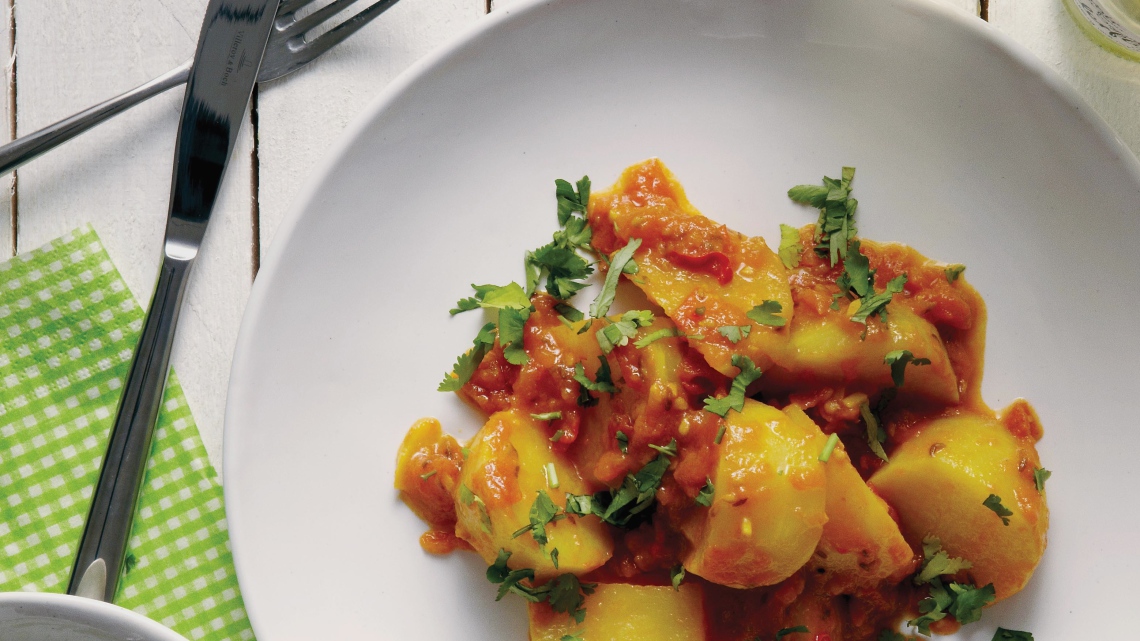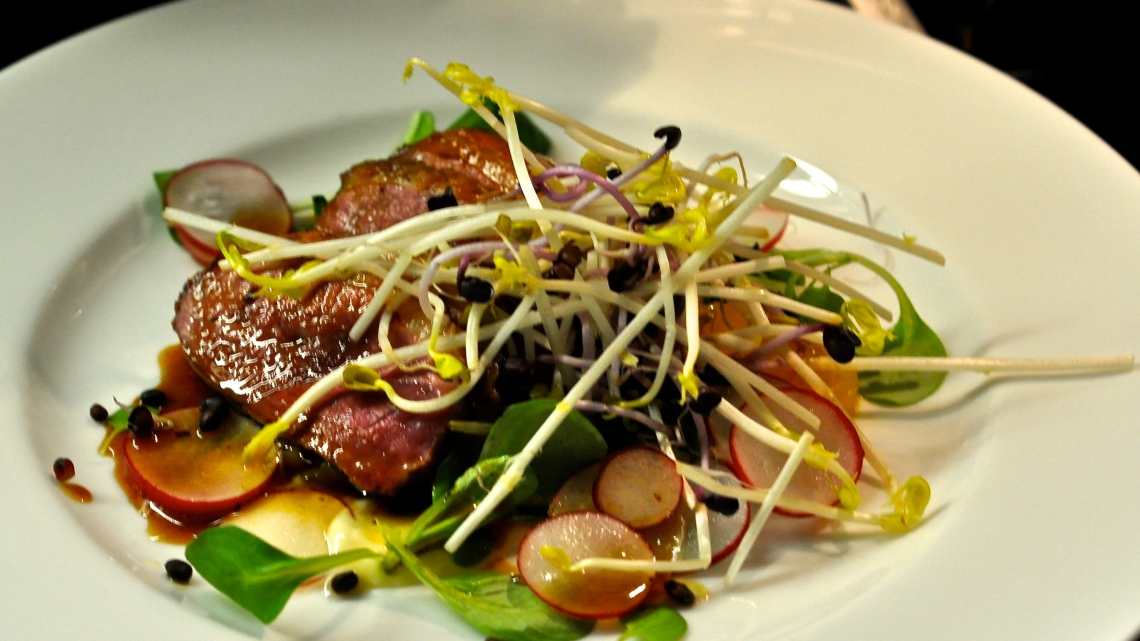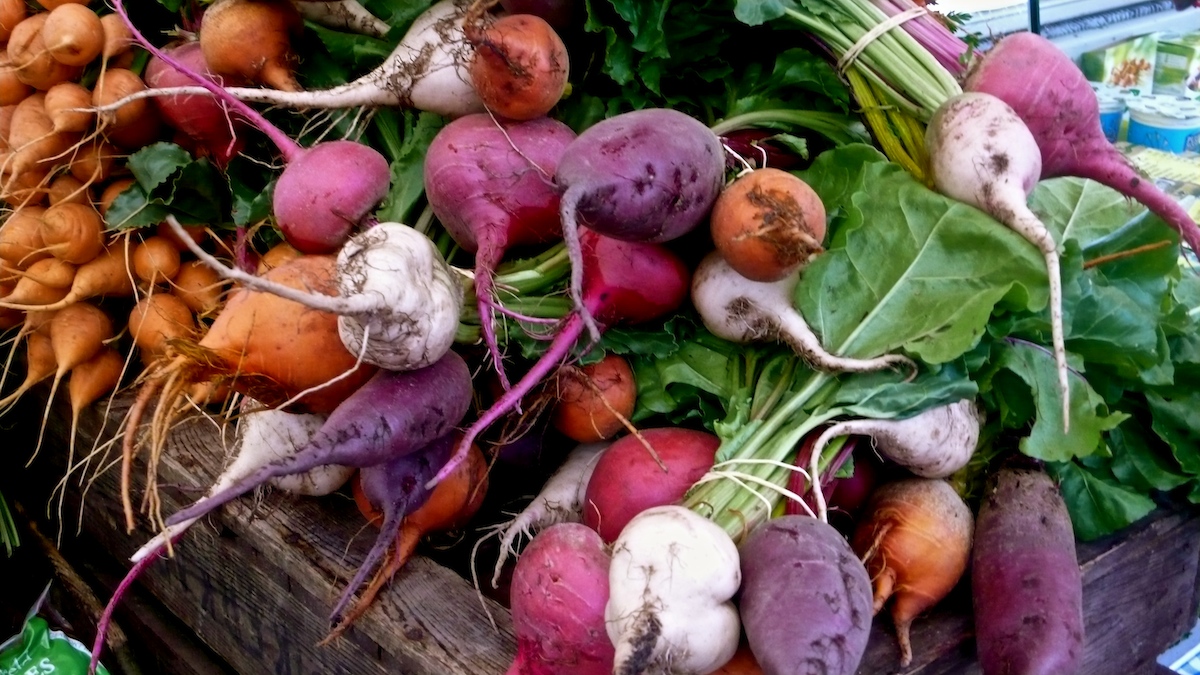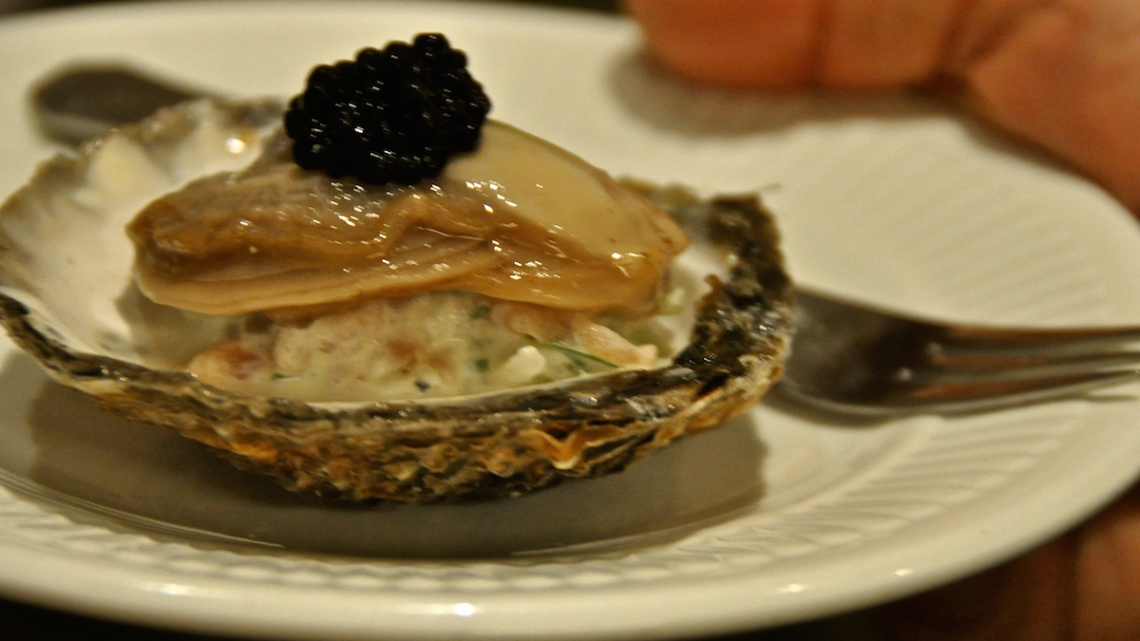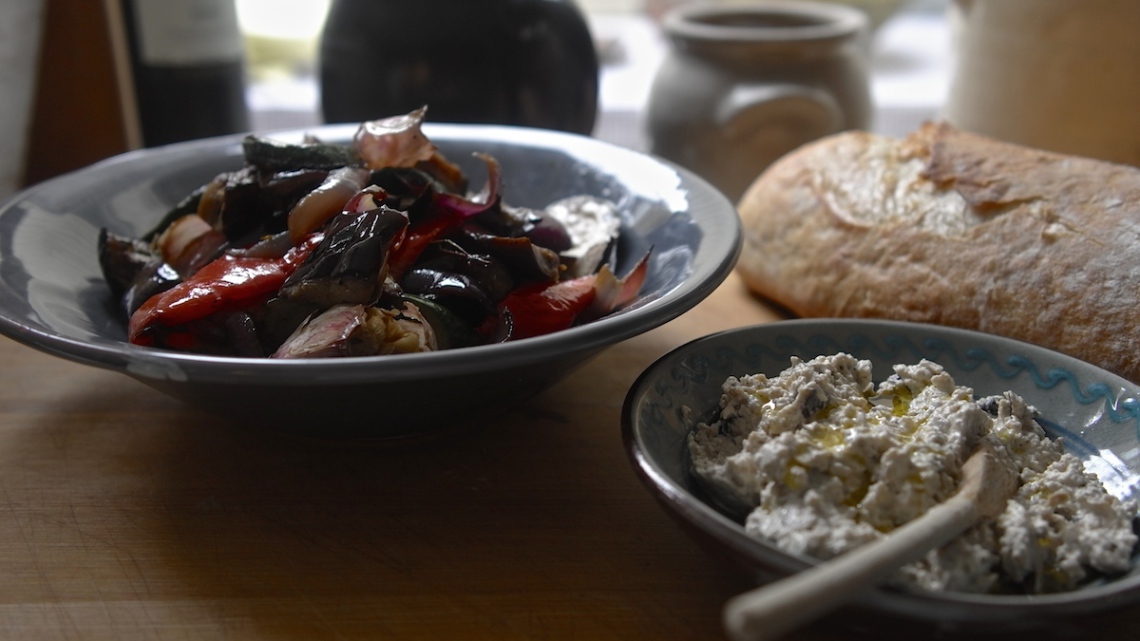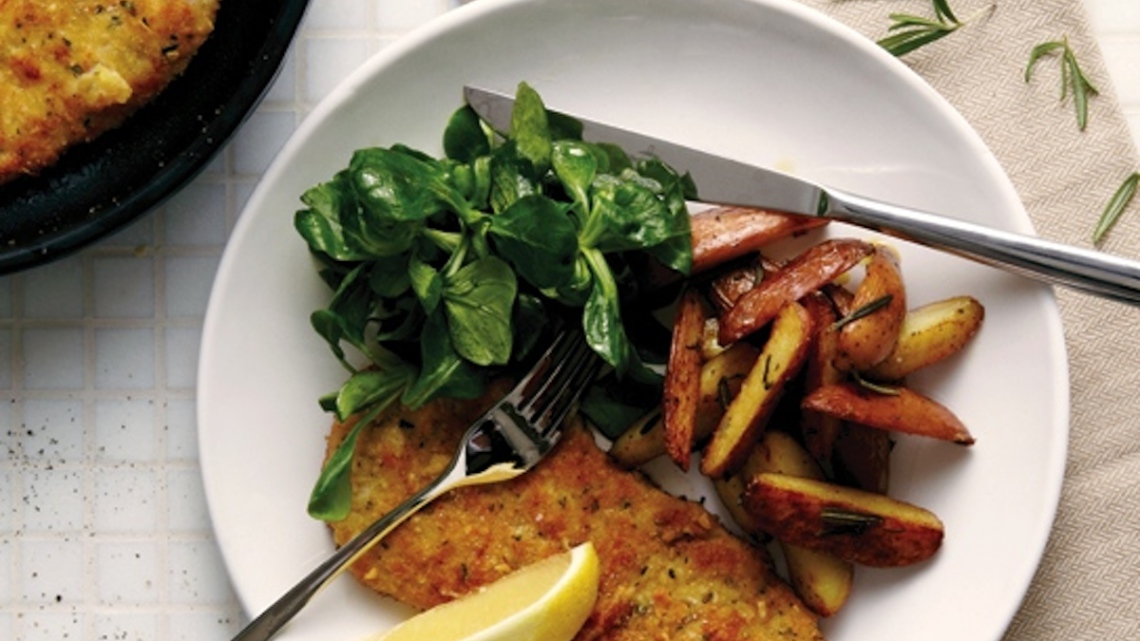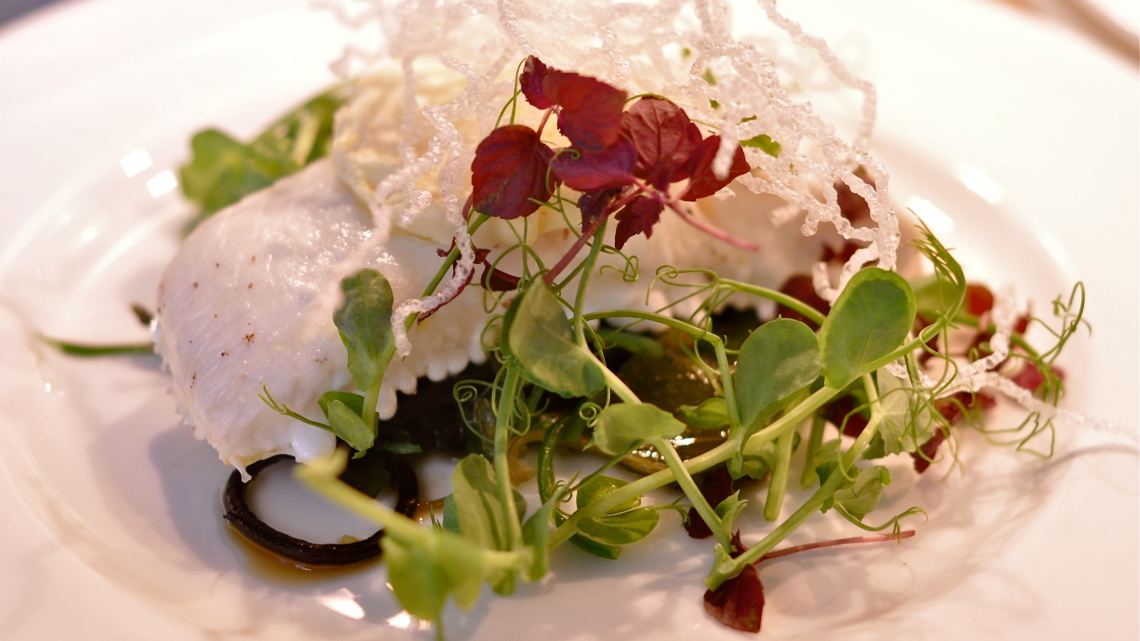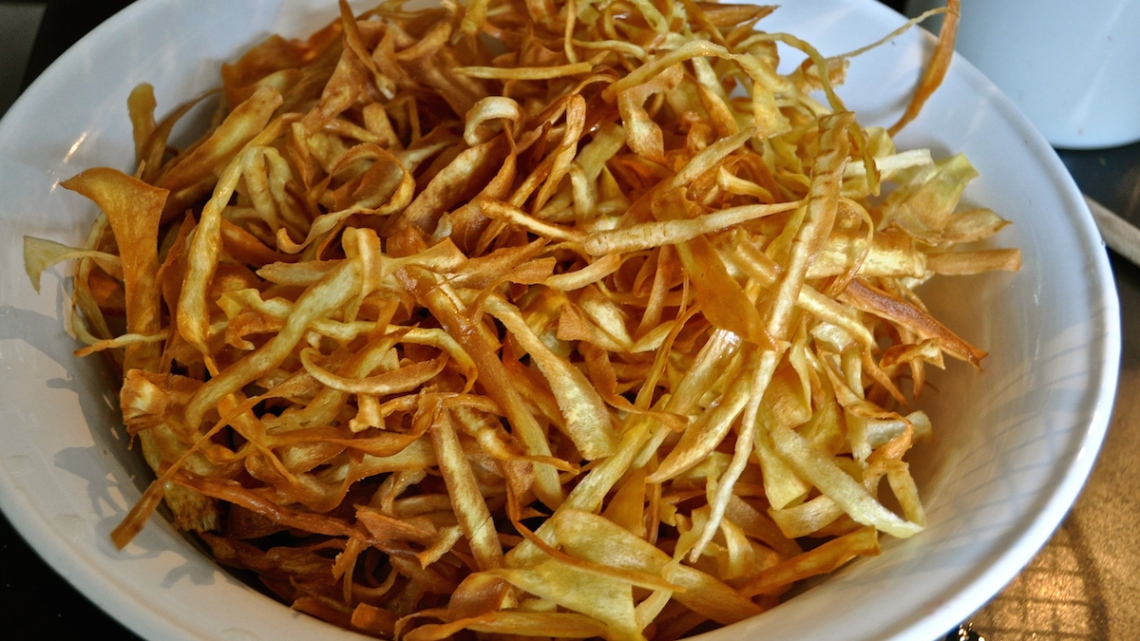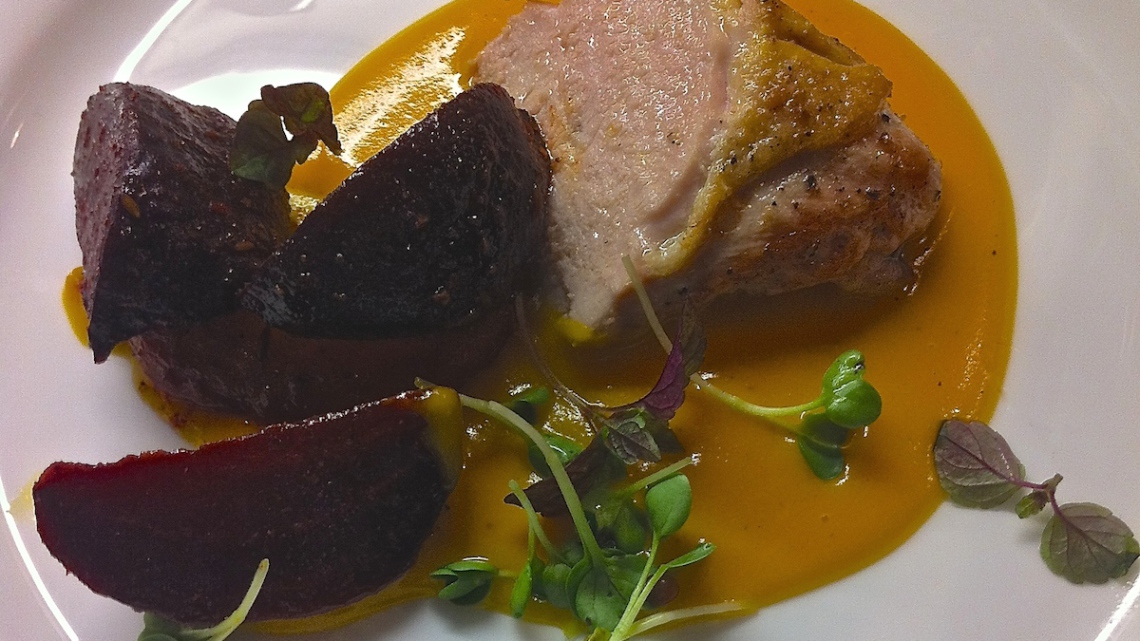Sole and Scallop 'Roulades' with Samphire and Beurre Blanc
Serves 4 as a starter
Ingredients
4 sole fillets, skinned and cleaned (ask your fishmonger)
4 scallops, cleaned
200 g samphire, rinsed
small pot caviar (we use herring caviar)
salt and pepper
extra splash of white wine for cooking the roulades
Beurre Blanc
150 mlwhite wine or ½ white wine and ½ white wine vinegar
1 shallot, finely chopped
1 piece of mace
2 cloves
1 bay leaf
2 tablespoons cream or crème fraiche
150-200 g butter
Method
Heat a frying pan over medium high heat with 2 tablespoons olive oil. Season the scallops lightly with salt and pepper and fry for about 1 minute on each side until golden. Remove from the pan and allow to cool.
Lay the sole fillets on a work surface and season lightly. Roll a cooled scallop in each and place in a roasting dish (This can be done ahead of time and placed in the fridge). Preheat the oven to 180 C.
Make the beurre blanc. Pour the wine into a thick-based pan. Add the shallot, mace, cloves and bay leaf and bring to the boil. Allow to simmer until reduced to about 2 tablespoons.
Add the cream and allow to cook for a moment, lower the heat slightly and “mount” the sauce by whisking in the cold butter in small pieces, moving the pan from the heat when necessary so that the butter thickens and emulsifies. Season with salt and pepper, strain the liquid through a fine sieve and return to the pan. Leave in a warm place till needed.
Pour a splash of white wine around the fish and cook in the oven for about 10 minutes until the sole fillets are just cooked and the scallop warmed through. In the meantime, stir fry the samphire in a frying pan with a splash of olive oil for about 3 minutes until it still has a little bite and is bright green.
To plate, place a 'nest' of samphire on each plate. Set a roulade in the middle of each, top with a small teaspoonful of caviar and spoon the beurre blanc around.
NOTE: It’s best to finish the sauce with the butter just before you need it.
We, the Amsterdam Flavours chefs, hope you enjoy this recipe as much as we do. If you have any questions on how to prepare it or just want to send us your feedback, you can reach us here Contact Amsterdam Flavours
Spicy Kohlrabi
Kohlrabi is an unsual vegetable which isn't well known. You've probably seen at at the green grocers but have never know what to do with it. Well, here's an easy and flavour vegetarian recipe with kohlrabi as the star.
Serves 4
Ingredients
1,3 kg kohlrabi
1 teaspoon cumin seeds
1 heaped teaspoon turmeric
3 cloves garlic
1 red chilli pepper
6-8 tomatoes
small bunch coriander
300 g basmati rice
4 Tablespoons olive oil
salt and pepper
Method
Bring a small pot of salted water to the boil for the rice. Slice the ends off the kohlrabi and peel. Cut each into 8 pieces. Finely slice the chilli into rings and finely chop the garlic. Cube the tomatoes.
Heat a frying pan over medium-high heat. Add 4 tablespoons olive oil to the pan, followed by the chilli pepper and garlic. Fry briefly and then add the kohlrabi. Fry for 1 minute. Add the cubed tomatoes.
Add the cumin seeds and turmeric, a pinch of salt and 150 ml water to the pan. Cover with a lid and cook gently for 20-30 minutes until the kohlrabi is tender (the point of a knife should pierce through easily).
Add the rice to the small pan and boil for 8-10 minutes. Drain off the water and keep the rice warm.
Finely chop the coriander and stir half through the rice. Place the rice in a serving bowl.
Divide the spicy kohlrabi between 4 plates. Scatter with the remaining coriander and serve the rice on the side.
We, the Amsterdam Flavours chefs, hope you enjoy this recipe as much as we do. If you have any questions on how to prepare it or just want to send us your feedback, you can reach us here Contact Amsterdam Flavours
Duck Salad with Preserved Lemon Aioli
Serves 4
Ingredients
4 duck breasts
salt and pepper
2 oranges, peeled and segmented
small bunch of radishes, finely sliced
75 g lamb's lettuce
1 container pea shoots
1 container beetroot cress
Preserved Lemon Aioli
75-100 g preserved lemon (or to taste)
1 large clove garlic
2 egg yolks
1 teaspoon lemon juice
salt
250 ml sunflower oil
Dressing
2 tablespoons orange juice
2 teaspoons soy sauce
2-4 teaspoons honey (or to taste)
Method
Preheat the oven to 180 C. Begin with the aioli. Finely chop the preserved lemon and garlic. Place in a magimix (food processor) with the egg yolks, lemon juice and salt, to taste. Blend until the mixture is smooth. With the motor running, slowly pour the sunflower oil in until the ingredients have emulsified and formed a mayonnaise. Check the seasoning and set aside.
Place all the dressing ingredients in a bowl and whisk to combine.
Score the fat of the duck diagonally with a small sharp knife, making sure you don't cut into the meat. Season with salt and pepper. Heat a non-stick frying pan over a medium-low heat and fry the duck, fat side down in a dry pan to render as much of the fat of as you can.
As the fat accumulates, carefully pour it off into a bowl. After about 5 minutes when the fat has cooked away and has turned golden brown, increase the heat of the pan to high, flip the duck over and fry on the meat side for 1 minute. Transfer to a roasting dish. Place in the oven for about 8 minutes. You want the duck to still be pink. Remove from the oven and rest for about 5 minutes.
Place a spoonful of the aioli on the base of each plate, spreading it out a little. Arrange the orange segments, radishes and lamb's lettuce on top. Slice the duck breasts and arrange them on top. Drizzle with the orange dressing, top with the pea shoots and beetroot cress and serve.
We, the Amsterdam Flavours chefs, hope you enjoy this recipe as much as we do. If you have any questions on how to prepare it or just want to send us your feedback, you can reach us here Contact Amsterdam Flavours
Roasted heritage beetroot
Get your beet on! As a side for dinner tonight, try roasting some heritage beetroot. Line an oven tray with a long piece of foil. Lay on the beet, add some whole, unpeeled garlic cloves, thyme, bay, olive oil, salt and pepper. Wrap up loosely with the foil and bake in the oven at 200C for about an hour or until the beets are tender. Peel and serve with a protein of your choice or turn into a salad with a vinaigrette, some herbs and goats cheese.
Chilled Oysters with Caviar
This is perfect to serve as a canapé or serve 3 to 4 as a starter.
Ingredients
1 cucumber, cut into thin julienne
2 slices of smoked salmon, cut into thin julienne
2 shallots, finely chopped
12 sprigs of dill, finely chopped
375ml crème fraiche
salt and pepper
lemon juice, to taste
24 Gironde oysters
1 pot Avruga caviar
Method
Gently mix the julienne of cucumber and smoked salmon with the shallots and dill. Season the crème fraiche with salt and pepper, add just enough of the crème fraiche to bind the cucumber mixture. Add a little lemon juice to taste.
Open the oysters and clean the deep half shells. Place the shells on four oyster plates and fill with the cucumber and salmon mixture.
Place the oysters back in their shells and add a teaspoon of caviar to each. Serve immediately.
For an alternate presentation, or if you don’t have any oyster plates, serve the oysters on a bed of very fine julienne of carrots, leeks and beetroot.
We, the Amsterdam Flavours chefs, hope you enjoy this recipe as much as we do. If you have any questions on how to prepare it or just want to send us your feedback, you can reach us here Contact Amsterdam Flavours
Weekend Lunch
Before you go to the market this weekend and restock your fridge with fresh produce, use up the vegetables you have left in the fridge for lunch. Here are 2 easy ways:
Roasted Vegetables
Heat the oven to 200 C. Roughly chop and aubergine, red pepper, courgette and a couple of red onions. Toss them in a roasting dish with some fresh thyme and a couple of whole, unpeeled garlic cloves, olive oil, salt and pepper. Roast for about 20-30 minutes until the vegetables are tender and tinged with a golden hue. Serve warm or at room temperature.
Aubergine Spread
Take 2 aubergines, and chop them into 1 cm cubes. Heat a griddle pan over medium-high heat. Toss the aubergine cubes in olive oil and grill until tender and coloured. Season with salt and pepper. Place half in a food processor with a couple of tablespoons good mayonnaise, 2 tablespoons olive oil and a squeeze of lemon juice. Pulse to a chunky puree. Transfer to a bowl and fold the remaining aubergine pieces through. Season with salt and pepper and serve.
Lemon, Parmesan and Pine Nut Encrusted Schnitzels
Serves 4
Ingredients
4 pork or veal escalopes
75 g bag panko breadcrumbs
1 lemon
75 g Parmesan, grated
50 g pine nuts
3 sprigs rosemary
100 g lambs lettuce
10 roseval potatoes
11 tablespoons olive oil
4 tablespoons flour
2 eggs
salt and freshly ground black pepper
balsamic vinegar, to taste
Method
Wash the potatoes and cut lengthways into quarters. Heat 5 tablespoons olive oil in a frying pan and fry the potatoes together with the leaves from 2 sprigs rosemary for 15-20 minutes. Season with salt and pepper. (This can also be done in the oven for about 30 minutes at 180 C instead of in a pan).
Grate the zest from the lemon and mix with the Parmesan and panko in a bowl. Finely chop the leaves from the remaining sprig rosemary and the chop the pine nuts and add to the panko/Parmesan mix. Combine well.
Place the flour on to a plate and beat the eggs in a small bowl.
Season the schnitzels with salt and pepper. Dust them in the flour, then dip in the beaten egg and finally press the panko mixture on firmly.
Heat 4 tablespoons oil in a frying pan and fry the schnitzels for 2-3 minutes on either side until golden brown and crispy. Cut the lemon into wedges.
Dress the lamb’s lettuce with 2 tablespoon olive oil and a few drops of balsamic vinegar. Serve the schnitzels with the salad, the fried potatoes and a wedge of lemon.
We, the Amsterdam Flavours chefs, hope you enjoy this recipe as much as we do. If you have any questions on how to prepare it or just want to send us your feedback, you can reach us here Contact Amsterdam Flavours
Halibut with Seaweed Salad
Serves 4
Ingredients
4 halibut fillets, about 150-175 g each
1 shallot
200 ml white wine, plus a little extra for the fish
60 g butter, at room temperature
small bunch basil
2 Tablespoons soy sauce
1 Tablespoon sesame oil
1 bag dried mixed seaweed (about 50 g in weight)
30 g pickled ginger, finely chopped
mixed cresses, to garnish
olive oil, for greasing
salt
pepper
Method
Preheat the oven to 180° C. Finely chop the shallot and add it to a small pot with 200 ml white wine. Bring to the boil and cook until the liquid as reduced down to 1 tablespoon. Allow the shallot and wine to cool down. Soften the butter in a bowl. Finely slice the basil into thin strips (chiffonade), add it to the butter along with the shallot and white wine mixture, salt and pepper.
Mix the ingredients well. Spoon the butter on to a piece of cling wrap, shape into a cylinder and refrigerate until the butter has firmed up.
Place the seaweed in a bowl and add enough hot water from a recently boiled kettle so that the seaweed is completely covered. Stand for 15 minutes until the seaweed has softened. Drain off and set aside. Make the dressing for the seaweed salad; finely chop the pickled ginger. Add to a small bowl with the soy sauce and sesame oil. Set aside.
Grease a roasting tray with a few drops of olive oil. Lightly season the brill fillets with salt and pepper. Place in the tray, pour 50 ml white wine around the fish, cover with aluminium foil and place in the oven for about 8-10 minutes or until the fish is just cooked.
Dress the seaweed salad with the dressing and divide between 4 plates. Set the fish on top of the salad and sprinkle over the cresses.
Thinly slice the butter. Lay a slice on each piece of fish and serve straight away.
Tip: If there is any butter over, this can be stored in the freezer for use again.
To give the dish extra crunch, you can top the fish with rice vermicelli noodles which have been deep-fried until they have puffed up and become crispy.
We, the Amsterdam Flavours chefs, hope you enjoy this recipe as much as we do. If you have any questions on how to prepare it or just want to send us your feedback, you can reach us here Contact Amsterdam Flavours
Parsnip Chips
Parsnips are in season at the moment. Instead of roasting, mashing or making soup out of them, why not turn them into chips.
It couldn't be simpler. Take a bunch of parsnips and wash off any dirt. Peel them with a vegetable peeler and top and tail them. Using the vegetable peeler, take long, thin strips, the entire length of the parsnip. You could also slice them into rounds on a mandolin if you have one, but please watch out for your fingers!
Heat a pan with sunflower oil to deep fry, or use a deep fryer set at 170 C. When the oil is hot, deep fry the parsnips. Don't over load the pan, but rather do it in batches. Also, make sure the oil is not too hot - parsnips contain a lot of natural sugars and therefore can brown very quickly. Once they're a lovely light golden colour, remove with a slotted spoon onto some kitchen paper to drain. Repeat until all the parsnips have been used up. Season with salt. They can be stored for a day or two in an airtight container.
Parsnip chips make a great textural garnish, adding some crunch, to any meat main dish from beef, chicken to game. They also make a great snack with drinks. So much better than supermarket chips and a great way to impress your friends!
We, the Amsterdam Flavours chefs, hope you enjoy this recipe as much as we do. If you have any questions on how to prepare it or just want to send us your feedback, you can reach us here Contact Amsterdam Flavours
Guinea Fowl with Pumpkin Sauce and Roast Beetroot
Serves 4
Ingredients
4 guinea fowl breasts
olive oil,
salt and pepper
mixed cress to garnish
Beetroot
2kg mixed beetroot, washed
olive oil
garlic cloves, skin on
beriyani spices
coarse sea salt and black pepper
Pumpkin Sauce
3 tablespoons olive oil
500g guinea fowl trimmings or carcasses
1 shallot, finely chopped
300 g pumpkin or butternut squash, cut into cubes
50 ml Cabernet Sauvignon vinegar
200 ml sweet white wine
1 bouquet garni (parsley, thyme, bay leaf, celery)
1 vanilla pod, split lengthways
3 star anise
500 ml chicken or vegetable stock
40 g butter
salt and pepper
Method
Peel the beetroot and lay in a roasting tray. Season with salt and pepper, sprinkle with the beriyani spices and drizzle with the olive oil. Scatter over the garlic cloves.
Place in a 180°C oven for at least and hour, depending on the size of the beetroot, until tender. Keep warm.
Peel the beetroot and lay in a roasting tray. Season with salt and pepper, sprinkle with the beriyani spices and drizzle with the olive oil. Scatter over the garlic cloves.
Place in a 180°C oven for at least and hour, depending on the size of the beetroot, until tender. Keep warm.
Heat the olive oil in a saucepan and add the guineafowl trimmings or carcasses and brown over a medium-high heat. Pour out any excess fat. Add the shallot and pumpkin and sweat over low heat for about 5 minutes. Add the vinegar and reduce by about half. Add the sweet white wine and reduce until only one-third of the liquid remains. Add the bouquet garni, vanilla pod, star anise and stock. Simmer over low heat for about 45 minutes. Work through a sieve into a clean plan, pushing the soft pumpkin through. Whisk the butter in over a low heat and season with salt and pepper. Set aside.
Season the guinea fowl with salt and pepper. Heat a frying pan with 2 tablespoons olive oil and fry the guinea fowl breasts, skin-side down, until golden brown. Turn over on to the meat side and fry for a further 1 minute. Transfer to an oven tray.
Place the guinea fowl in the oven for 10-12 minutes until just cooked. Remove from the oven and allow t rest, loosely covered with aluminium foil for 5 minutes.
Slice the guinea fowl breasts. Place a pool of sauce on each plate. Lay the sliced guineafowl on top and the beetroot to the side. Garnish with a few mixed cress.
We, the Amsterdam Flavours chefs, hope you enjoy this recipe as much as we do. If you have any questions on how to prepare it or just want to send us your feedback, you can reach us here Contact Amsterdam Flavours


